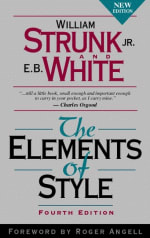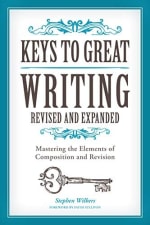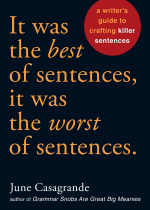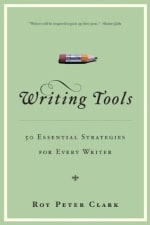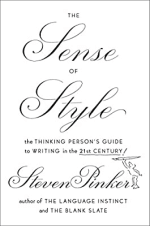The 12 best resources for improving your writing
(By the way, to get articles like this free in your inbox, subscribe to our newsletter.)
—including an amazing book that hardly anyone knows about.
(This is one of a series of articles, the first of which is here.)
Why you should learn to write clearly—and why so few people are good at it
When we ask a website’s visitors why they didn’t buy, they often report that they were confused. They hadn’t understood the words on the site. And visitors can’t buy what they can’t understand.
So, with millions of dollars at stake, why are many websites confusing?
Because writing intelligibly is harder than it sounds. For example, read the following sentence from The Guardian, written by an otherwise great writer:
“Dance music aficionados can argue interminably over which of the legendary singles Frankie Knuckles produced in the late 80s – singles, you can say without fear of contradiction, that played a part in changing the face of pop music for ever – is the best.”
That sentence is free of typos and punctuation errors. And it uses sophisticated words accurately. According to many rules of English, it’s written well.
Yet most people struggle to understand it, let alone work out what’s wrong with it, or how to fix it.
It’s hard to write clearly. In fact, it’s hard to find someone who can teach you how to write clearly. Schools tend to spend more time teaching pupils how to sound smart, or how to analyze Shakespearian prose, than how to be understood. Students are more likely to be told to memorize poetry than to carry out a readability test.
This is a disservice. Poetry can be life enriching, but the purpose of almost all writing is to communicate information.
So if your school didn’t teach you how to write intelligibly, how can you learn?
This article contains some fantastic resources for helping you to write more clearly. They have helped us to generate hundreds of millions for our clients. It’s hard to overstate how useful they are.
But first, let’s explore why so many writers are hard to understand.
Many books teach you to avoid errors. But that’s not the problem.
When most people want to improve their writing, they buy a book like “Eats, Shoots & Leaves: The Zero Tolerance Approach to Punctuation,” which is about how to avoid making mistakes. Such books describe rules like the following:
- “When there are brackets at the end of a sentence, put the period after the closing bracket (like this).”
- “If your whole sentence is in brackets, put the period inside the closing bracket. (Like this.)”
Such rules are useful to know, but they make little difference to whether your readers understand what you are saying.
Many teachers specialize in sounding intelligent. If you follow their advice, your sales will plummet.
Many teachers encourage writing in what Richard Lanham calls the “Official Style”—a style that sounds intelligent but which is hard to read. Lanham’s book Revising Prose teaches you how to translate Official-Style sentences into plain English. It contains the following example of how Warren Buffett, the world’s most-famous investor, translated a fund prospectus into plain English:
A paragraph written in the hard-to-read Official Style (good luck with understanding it!): “Maturity and duration management decisions are made in the context of an intermediate maturity orientation. The maturity structure of the portfolio is adjusted in anticipation of cyclical interest rate changes. Such adjustments are not made in an effort to capture short-term, day-to-day movements in the market, but instead are implemented in anticipation of longer term, secular shifts in the levels of interest rates (i.e. shifts transcending and/or not inherent in the business cycle). Adjustments made to shorten portfolio maturity and duration are made to limit capital losses during periods when interest rates are expected to rise. Conversely, adjustments made to lengthen maturation for the portfolio’s maturity and duration strategy lie in analysis of the U.S. and global economies, focusing on levels of real interest rates, monetary and fiscal policy actions, and cyclical indicators.”
The same paragraph rewritten in plain English by Warren Buffett: “We will try to profit by correctly predicting future interest rates. When we have no strong opinion, we will generally hold intermediate term bonds. But when we expect a major and sustained increase in rates, we will concentrate on short-term issues. And, conversely, if we expect a major shift to lower rates, we will buy long bonds. We will focus on the big picture and won’t make moves based on short-term considerations.”
No wonder fellow investors hang on Buffett’s every word.
The Official Style is prevalent in academic literature too. On the website LOLMyThesis, graduates self-deprecatingly translate the titles of their theses from the Official Style into plain English, usually to comic effect:
- Original title of thesis: “Environmental Enrichment and the Striatum: The influence of environment on inhibitory circuitry within the striatum of environmentally enriched animals and behavioural consequences.” Rewritten title: “Having toys and bright colours in their cages makes mice smarter in their brains!”
- Original title of thesis: “Challenging Ritual and Exploring Deposition within the Canals of Chavín de Huántar.” Rewritten title: “Ancient Peruvians threw stuff down a drain: maybe it was ritual, probably just trash.”
- Original title of thesis: “The Punch Brothers’ The Blind Leaving the Blind: How Heterogeneous Stylistic Techniques Provide New Interpretations of Genre.” Rewritten title: A band that detests genre classifications is just gonna have to put up with it.
The rewritten titles are facetious, and many of them omit useful information. But they also reveal a truth: The Official Style is like medieval armour. It defends you from attack, but people can no longer hear what you’re saying.
If you were to write your website in the Official Style, your conversion rate would bomb. Your visitors would leave confused. Teachers and bosses may like intelligent-sounding text, but readers prefer text that’s easy to understand.
How to write so that people will understand you
Faced with all this bad advice, how can you learn to write well? The following tools, techniques, and books will help enormously.
A simple technique that helps you to write easy-to-read copy
The first technique for improving your writing is simple: Carry out readability tests. A readability test is simply a usability test carried out specifically on a piece of writing. We won’t go into detail about usability tests here; we described them in detail in our article “How to make millions from user testing.”
Speak first, write later
If you struggle to write clearly, you will find the following workaround useful. One of our clients, a company called Moz, had a common problem. Moz’s founder, Rand Fishkin, mentioned that in seven minutes he could persuade almost anyone to sign up. So face to face, Rand’s conversion rate was high. But he was frustrated that his website’s conversion rate was much lower.
We asked Rand to film himself saying what he would say during those seven minutes.
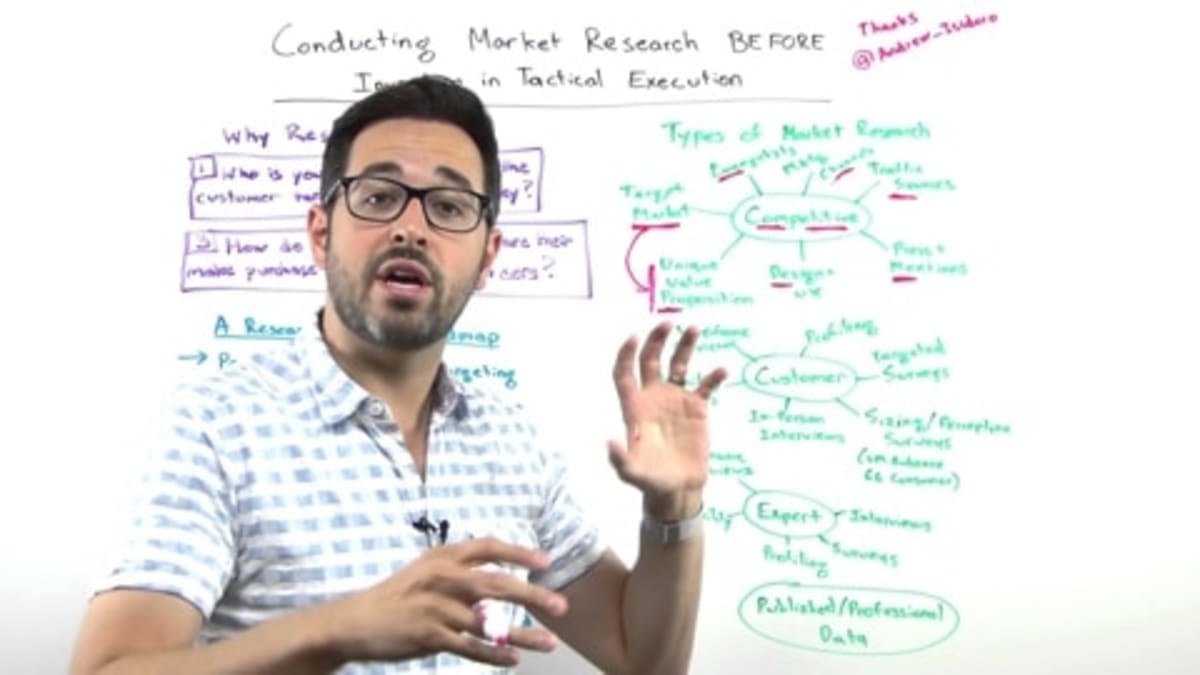
We transcribed the video, then used the transcript as a template for the company’s new landing page. And we embedded the video itself into the page.
The new page beat the old one, having a 52% higher conversion rate during the A/B test. Rand reported that, in total, we almost tripled his company’s conversion rate. If you’d like to learn more about this project, see this detailed case study.
Many people find that their spoken English is easier to understand than their written English. If you are one of those people, try the following workflow:
- Record yourself.
- Get the recording transcribed. We highly recommend SpeechPad for fast, accurate transcription.
- Edit your transcript and incorporate it into your website.
- A/B test the new page to confirm that your changes have increased your profits.
Hemingway app “makes your writing bold and clear”
Hemingway highlights long, complex sentences and common errors. It’s free. You won’t agree with all of its suggestions, but it provides a fresh pair of (robot) eyes. We use it regularly.
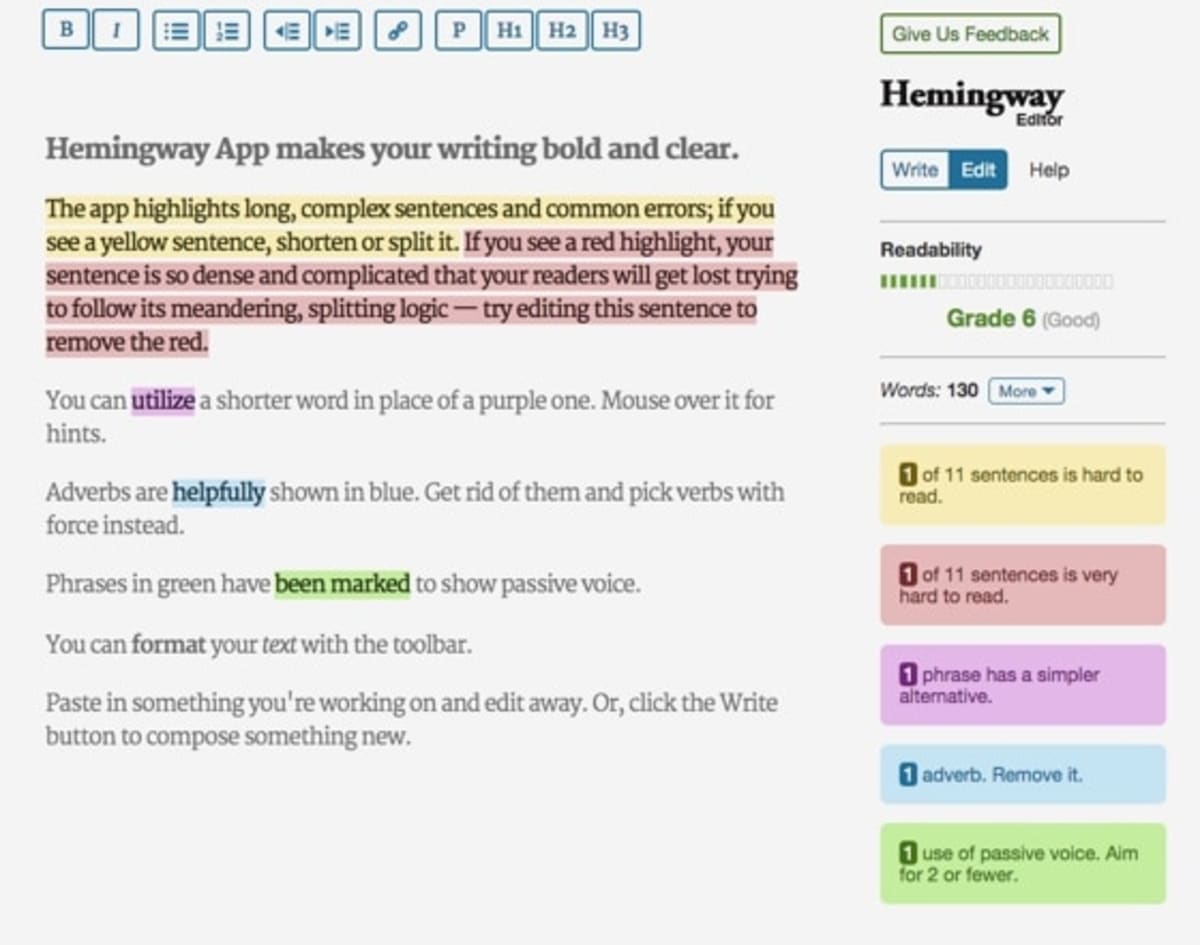
Grammarly is “the world’s most-accurate grammar checker”
Grammarly is the best proofreading tool we’ve found. Like Hemingway (the app, at least), it isn’t always right, but it can point out mistakes that you have overlooked.
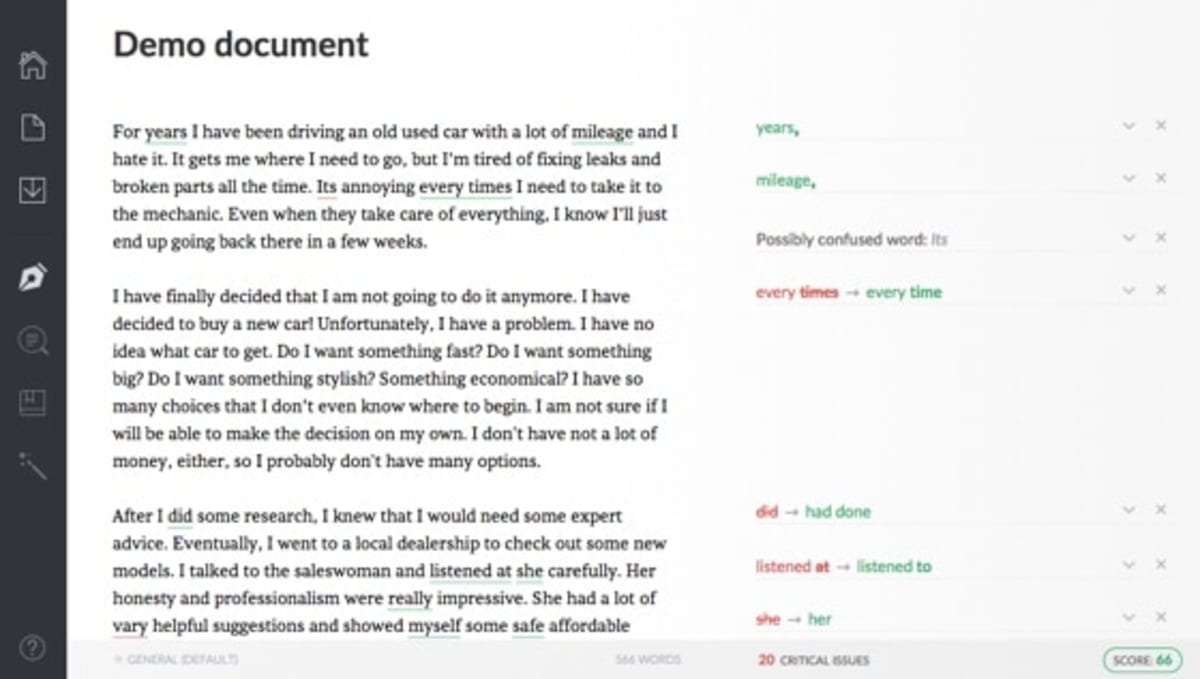
Some fantastic books for improving your writing
On our office bookshelf, we have 52 books about writing, but only a few of them will help you to improve the clarity of your writing.
We recommend you start at the top of the following list and work your way down. If punctuation bores you, don’t be deterred. Most of the books aren’t about grammatical pedantry; they are about simple, practical techniques that will transform you into a better writer.
Free guides from the Plain English Campaign
The Plain English Campaign has some useful free guides. Start with “How to write in plain English.” Then read “The A to Z of Alternative Words,” which urges you to use words like use instead of utilizing words like utilize.
The Elements of Style by Strunk and White
Skip the first half of this book (sorry, Strunk!), because the following book by Hacker and Sommers trumps it. Instead, just read the second half (the section written by E.B. White), which concisely describes how to write clearly—and why it’s important to do so.
A Pocket Style Manual by Diana Hacker and Nancy Sommers
This is the only book that we keep on our desks. The first hundred pages contain many techniques for making your sentences easy to read. They include all the grammar and punctuation advice you’ll ever need (explained extremely concisely), plus many tips for readability. Good news: You can probably ignore everything after page 86.
Keys to Great Writing by Stephen Wilbers
The first half of this book (Part 1) is awesome, good enough to make the book our favorite book on this list. It teaches you the mechanics of writing well. It’s brilliantly concise, and is full of techniques that actually work. You have probably never heard of most of them. You may enjoy this book even if you hated English classes at school. We suspect that it particularly appeals to programmers, because it provides a much-needed logical framework for writing. The book summarizes several other books, including two other favorites of ours: Style: The Basics of Clarity and Grace and The Sense of Structure: Writing from the Reader’s Perspective.
It Was the Best of Sentences, It Was the Worst of Sentences by June Casagrande
This book is like looking into the mind of a copy-editor as they go about their work. It’s slightly more advanced than the books above, so you might want to leave it till you’re ready for some of the drier aspects of grammar and style. It’s very practical, though; it has the feel of a writing workshop.
Writing Tools – 50 Essential Strategies for Every Writer by Roy Peter Clark
Why have we begun this paragraph with a question that we immediately answer? Because that’s a useful literary technique for introducing a subject.
If you’d like to discover more literary techniques, this book is full of them. Once you become aware of each technique, you’ll begin to spot it in other people’s writing. If you want to study an article that’s full of such techniques, try this one.
The Sense of Style by Steven Pinker
Pinker is a cognitive scientist. In this book he explains how a knowledge of linguistics can help you to write better. By teaching you how language works, he helps you to become more intuitive about how to write well. If you want an even-deeper understanding of how language works, then read Pinker’s prior book The Language Instinct.
The Elements of Eloquence by Mark Forsyth
This book describes simple techniques that help you to write great phrases. The techniques appear in almost all great writing (particularly poetry, song lyrics and marketing slogans). This is one of those books that makes you wonder, “How come they resisted teaching me that at school? Did my teachers not know all those awesome techniques—but Shakespeare, Bob Dylan and Paul Simon did?” Unlike some books about writing, this one works great as an audiobook.
Read the next article in this series
This article is one of a series that began here. The next in the series is here. We’ve also published a list of our favorite marketing books.
How much did you like this article?
What’s your goal today?
1. Hire us to grow your company
We’ve generated hundreds of millions for our clients, using our unique CRE Methodology™. To discover how we can help grow your business:
- Read our case studies, client success stories, and video testimonials.
- Learn about us, and our unique values, beliefs and quirks.
- Visit our “Services” page to see the process by which we assess whether we’re a good fit for each other.
- Schedule your FREE website strategy session with one of our renowned experts.
Schedule your FREE strategy session
2. Learn how to do conversion
Download a free copy of our Amazon #1 best-selling book, Making Websites Win, recommended by Google, Facebook, Microsoft, Moz, Econsultancy, and many more industry leaders. You’ll also be subscribed to our email newsletter and notified whenever we publish new articles or have something interesting to share.
Browse hundreds of articles, containing an amazing number of useful tools and techniques. Many readers tell us they have doubled their sales by following the advice in these articles.
Download a free copy of our best-selling book
3. Join our team
If you want to join our team—or discover why our team members love working with us—then see our “Careers” page.
4. Contact us
We help businesses worldwide, so get in touch!
© 2024 Conversion Rate Experts Limited. All rights reserved.


